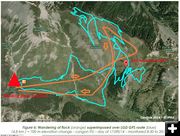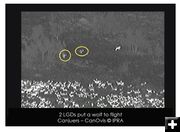

LGD sheep movement
The orange line depicts the movement of the sheep flock, while the blue line shows the travel of one of the flock's livestock guardian
dogs.
|


LGD chase
Two livestock guardian dogs put a wolf to flight after wolf attempts to approach sleeping sheep flock.
|
|
Wolf-Dog-Flock Trinity
by Cat Urbigkit, Pinedale Online!
May 15, 2015
Wolf researchers with the CanOvis Project continue to study the relationships between wolves, domestic sheep, and livestock guardian dogs in France, focusing on sheep grazing operations in two areas:
• Mercantour’s alpine landscape of grasslands, moores, wooded meadows and larch forest is home to five wolf packs (minimum of 15-24 wolves) and 145,000 head of sheep. In 2014, there were 675 wolf attacks with 2,353 small ruminant victims.
• Canjuers is a high plateau of small valleys, hills, steppe, meadow, scrubland, and forest. It’s home to two wolf packs (minimum of 10-13 wolves) and 15,000 of sheep. In 2014, there were 276 wolf attacks, with 804 small ruminant victims. According to CanOvis, "these two areas account for over 50% of damage nationwide and illustrate all the difficulties with overcoming flocks’ vulnerability to predation, despite the high level of livestock protection and the concerted efforts of breeders."
CanOvis has prepared its annual report and findings from the 2014 field season, detailed below. The CanOvis Project, led by Jean-Marc Landry, focuses on the following field research:
• LGD behaviour monitoring (individual behaviour, relationships within the pack of dogs and behaviour in their environment; interviews with the livestock breeders who own them and the shepherds who use them.
• GPS monitoring of LGDs and flocks (analysis of night- and daytime animal movements).
• Monitoring of wolf-flock-LGD interactions (night-time
viewing using infrared equipment – night-time hides close to where the flocks sleep).
• Reading of the contextual and circumstantial parameters
(topography, weather, pastoral activity, etc.).
• A collection of testimonies and experiences of partner
livestock breeders and shepherds.
Preliminary Results
The information gathered in 2013-2014 enables us to make some initial observations, which are gradually identifying the avenues of work to be explored. Some results are set out below, in a non-exhaustive way, classified by which is the central figure interacting with another player:
1. On wolves
• Wolves "occupy the territory": Wolves pass through observation areas regularly and not necessarily out of interest in flocks.
• Some wolves are persistent: on the other hand, individuals (one or two wolves together) focus on a flock for hours on end (waiting, observations, attempts... not necessarily with any result).
• Some wolves seem inexperienced: most of these persistent wolves seem daring but ineffective.
• Always one single wolf (maybe two) during the "unsuccessful" attacks that were observed.
• Wolves and LGDs can have "peaceful" relations: whereby each seems to recognise the other’s limitations and they tolerate each other.
2. On flocks
• The livestock are relatively tolerant of LGD movements, but some restless stages amongst the LGDs cause significant disturbances (panic, movement, etc.).
• The approach or very close proximity of wolves generally does not cause livestock to panic.
• When sleeping unenclosed, if attacked, the flock may move in bunches and create a "flocking" effect (like a shoal of fish), which disturbs the predator and gives
the LGD time to intervene. This means sleeping unenclosed is not necessarily a vulnerability factor.
• Adding fences (even non-electric) could be effective on open sleeping spots by
limiting key access points to the flock while reinforcing the work of
LGDs.
• After a disturbance, calm generally returns quickly.
• In a 24-hour cycle, some periods proved more vulnerable (grazing, scattered animals,
flock split up, easy access to the sleeping spot, etc.).
3. On guardian dogs
• LGDs are not necessarily on guard all night – they sleep at night too!
• LGDs are relatively tolerant towards the surrounding wild animals. Very few incidences of chasing observed.
• Whether dogs are excited or calm does
not necessarily correlate with the presence of wolves in the surroundings.
• Dogs’ "marking" and barking have little or no effect on wolf frequentation.
• The dogs are sensitive to sudden movements of the flock (and unusual ringing noises): LGDs only seem to demonstrate agonistic ("aggressive") behaviour towards wolves in the event of trouble/attack on the flock and, to a lesser extent, on a carcass (defense of resources). They are more "tolerant" to the presence and movement of wolves when there is no disturbance (even close to the flock).
• LGDs return to calm relatively quickly after a variety of attacks or trouble.
• Some pursuits can be sustained: up to 2 km where the LGDs "will not give up", with tracking work equivalent to a hunting dog, while other pursuits are abandoned after a
few dozen meters (simply putting them to flight).
• LGDs may interrupt wolves’ predation behaviour, but they do not teach the wolves not to come back to the protected flock. This means that dogs may be similar to a "disruptive-stimulus tools."
• The presence of one or several females in heat in the flock and surroundings seems to make protection less effective (reduced vigilance, males injured by fighting amongst
themselves and dogs wandering off from
their home flock, sometimes far from the flock).
Field research is set to continue in 2015.
"Every year since 2010, more than half of flocks that are attacked experience it once per season, around a third suffer two to five attacks, with around 10 % suffering six to 10 attacks and the rest (...) suffering over 10 attacks (...) These two last categories of flock (around 3 % of flocks in 2013) account for some 35 % of victims compensated in 2013." Wolf bulletin No. 31, French Hunting and Wildlife Agency (ONCFS), June 2014
To read the complete report for the 2014 field season, click on the link below.
|

